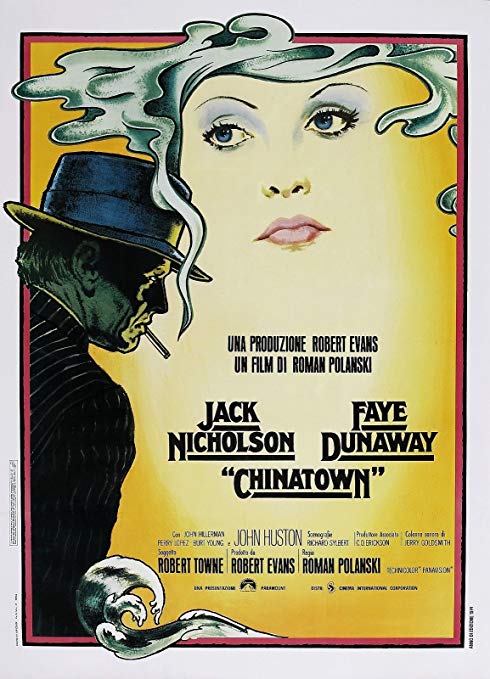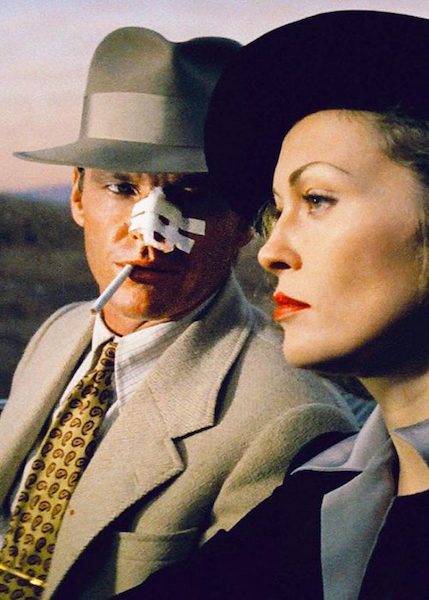Chinatown was released by Paramount Pictures on June 20, 1974
Produced by Robert Evans
Directed by Roman Polanski
Written by Robert Town
Chinatown cast: Jack Nicholson, Faye Dunaway, John Huston, Diane Ladd, John Hillerman, Burt Young, Perry Lopez, Joe Mantell, Darrell Zwerling, Bruce Glover, James Hong, and Richard Bakalyan
It’s not often that I get a chance to direct your attention to a work of exceptional quality, much less one of filmdom’s all-time classics; but this time, that is exactly what we have. Though it may only rank number 19 on the American Film Institute’s list of the top 100 films of all time, which is a travesty in my opinion, here at the Cpop Cinema, Chinatown ranks number one.
This film sits at the top of a very short list of films that I admire above all others — it’s just got the magic. There are a lot of movies out there, but this is a masterpiece. So much so that film students have been studying it ever since its release 47 years ago.
It’s one of those rare instances in which all the right pieces came together in perfect alignment—the right producer (Robert Evans), the right director (Roman Polanski), the right writer (Robert Town), and all the right players, who each left their own, indelible mark upon the film noir genre two decades after it had gone out of fashion. I can’t imagine that anyone involved in the making of this movie didn’t consider it the crowning achievement of their careers.

With Chinatown, the magic starts with the opening theme music. For just three soulful trumpet notes into Jerry Goldsmith’s bluesy score, and we’re transported to 1930s Los Angeles, which happens to be suffering through a drought, or so it would appear. The story is told from the perspective of private detective Jake Gittes (Nicholson) as he attempts to unravel a sinister mystery he has unwittingly been made a part of.
It doesn’t sound all that far removed from a lot of other noir films: you have the hardboiled detective, the femme fatal, the rich and powerful heavy, along with the familiar assortment of unsavory characters, and the police, who suspect everybody. It’s a world of cynicism, and deception, and corruption, and appalling secrets, and of course, murder. All pretty much standard noir elements, but Polanski and company have taken all these orthodox components and crated a very unorthodox and vastly superior film. Scenes progress at a brisk clip, but the action within the scenes moves at a more leisurely pace giving the film an almost dreamlike quality, which is enhanced by the very unorthodox use of burnished color and widescreen photography.
In the interest of those who have yet to witness this gem, I’ll not say anymore; just know that it is a beguiling, multi-layered, mystery that twists and turns its way toward a couple of shocking surprises waiting at the end—nuff said.
The production design, by Richard Sylbert, is really top drawer right down to the minuscule details of the real interiors. Polanski’s direction is smooth and well-paced, and the acting is superb. Every actor seems to have been born to play the roles they were assigned from the two stars all the way down to the bit players. But special mention has to be made of veteran character man, Joe Mantel, as Gittes assistant who utters what has become one of the most iconic lines in film history — “Forget about it Jake, it’s Chinatown.” But trust me, after you’ve seen it, you won’t forget about it—you’ll want to see it again.
Featured Califormulants
First among all the vintage Califormulants that appear in Chinatown is the story itself, which was loosely based on events that occurred 25 years before this story takes place (Cpop page 125).
All the rest of the Califormulants (save for the automobiles) are architectural. And what’s really fascinating about these structures is that they would have been familiar to the movie’s characters in 1937; they would have been familiar to the filmmakers in 1974; they were familiar to me in the 1980s; and they are probably still familiar to a great many people living there now. All of them, from the Spanish style apartment building (located in L.A. and built in 1928) to the Mulwray mansion (Pasadena, built in 1917), to the craftsman home (L.A. built in 1913), the courtyard apartments (L.A. built in 1904), and the Spanish style duplex (L.A. built in 1923) are still standing and in use today. The predominant styles on display — California Craftsman and Mission Revival — were very popular during the teens and 20s and you call still see them everywhere around Los Angeles.

Another interesting building featured in the film is the little neighborhood diner by the beach. It was very common in the first half of the 20th century to locate small diners and grocery stores right in the middle of residential neighborhoods. This one was built in 1936 and is still in operation.
The beautiful cars used in the film were a 1938 Packard convertible for Ms. Mulwray (Dunaway), a 1935 Ford Phaeton for Mr. Gittes (Nicholson), and a 1937 Cadillac Fleetwood 75 for Mr. Mulwray (Darrell Zwerling).
Other points of interest include the Echo Park Lake, the Foothill Boulevard Bridge over the Tujunga Wash, Point Fermin Park in San Pedro, the Stone Canyon Reservoir, the Catalina Island Yacht Club, and the Portuguese Bend Riding Club in Rancho Palos Verdes, all of which look very much like they did when the film was made.
For anyone who would like to see how these famous movie locations have fared over the years, the website Curbed Hollywood has a great page called The Ultimate Chinatown Filming Map of Los Angeles, and it is. I recommend you go have a look, but after you’ve seen the movie.
